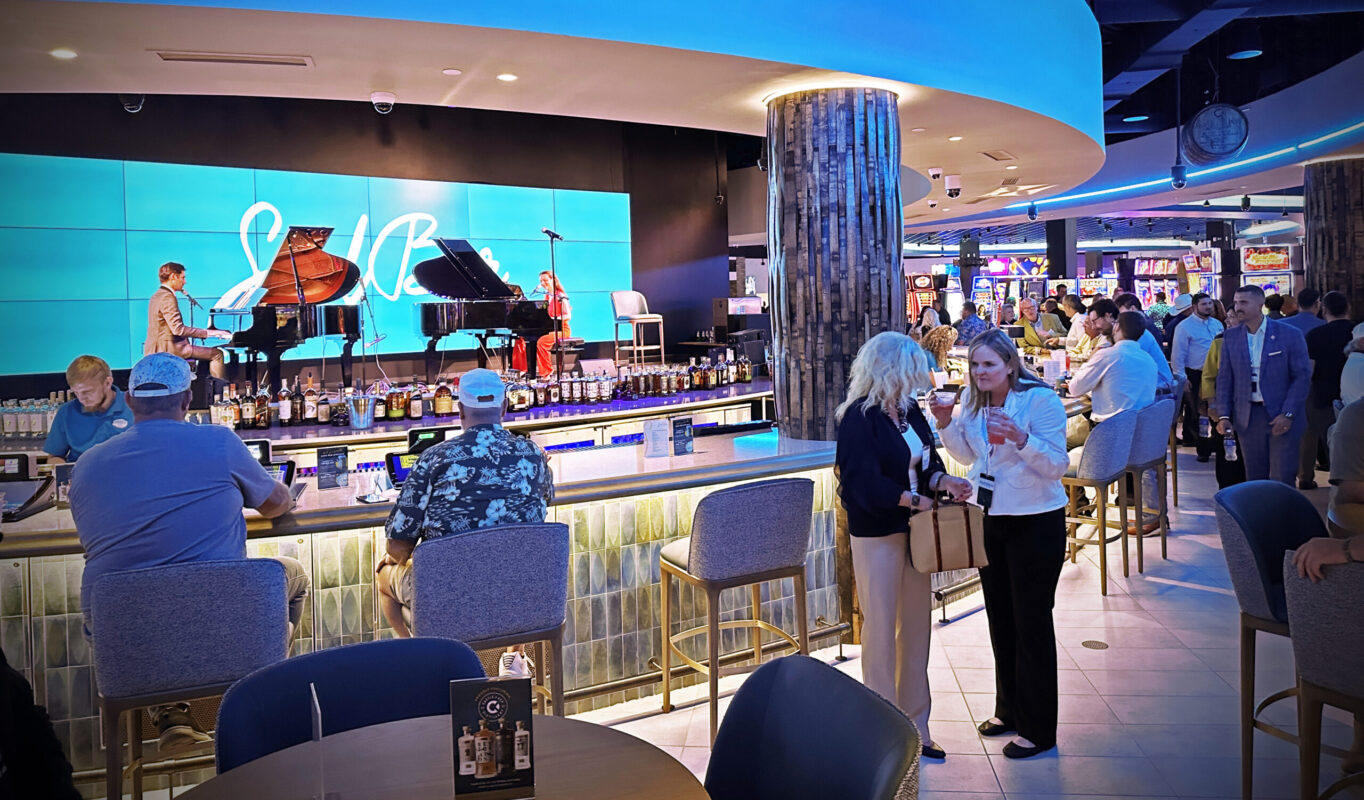Beyond the roaring crowds and excitement of the track, horse racing has consistently served as a significant driver of economic growth, revitalizing communities and fostering local development.
In the wake of the COVID-19 pandemic, the city of Ashland, Kentucky, faced a discouraging economic decline. At the heart of the community lay the Kyova Mall—once bustling with shoppers and the hum of commerce, the facility was filled with vacant storefronts and underutilized space. Seeking to revive the local area, community leaders embarked on an ambitious mission to transform the struggling mall into a dynamic entertainment destination featuring vibrant recreational attractions as well as diverse shopping opportunities.
As part of the redevelopment initiative, Revolutionary Racing, a real estate development and operations group specializing in horse racing and gaming facilities, identified the mall as the ideal location for a new historical horse racing (HHR) venue. To create an expansive attraction facility that included amenities like electronic gaming terminals, multiple bars, stages for live performances, and lounge areas, a vacant 75,000-square-foot flagship retail store was identified as the future location for Sandy’s Racing & Gaming. With an ambitious timeline, the project required extensive structural modifications, regulatory approvals, and meticulous coordination. KCI was engaged to assist the project’s design architect with site analysis, permitting, and design development, working against tight deadlines to bring the vision to life.
While the potential project drew immense support from stakeholders, the slated timeline for completion posed considerable complications. The team determined the initiative would require five phases: feasibility and site investigation, design development, permit drawings, construction drawings, and construction. Each phase had strict timelines that had to be met, while the entire compilation of work needed to be completed in only 18 months to meet the projected opening date.
The team wasted no time initiating the first phase, conducting feasibility and site investigations, structural analyses, and hazardous material surveys on the vacant retail building. During this phase, KCI engineers oversaw the visual inspection and documentation of all existing mechanical, electrical, plumbing, and fire protection systems within the space. Each analysis documented essential attributes of the building, including its capacity limitations and general condition, to inform the client’s decision-making. Upon the completion of each survey, a comprehensive report containing findings, land use overview information, zoning and regulatory restrictions, traffic assessments, estimated utility and permit requirements, environmental impacts, and an existing conditions plan was issued to the client. All information was compiled in only 26 days and approved by Revolutionary Racing immediately, enabling the team to progress to the next phase ahead of schedule.
 With a tight schedule and many elements to coordinate, our team successfully led efforts through construction completion while working closely with stakeholders every step of the way to bring the project to life.
With a tight schedule and many elements to coordinate, our team successfully led efforts through construction completion while working closely with stakeholders every step of the way to bring the project to life.With the client’s approval, KCI began drafting the project’s submission to the Kentucky Racing Commission to obtain required permissions. Additionally, the team traveled onsite to meet with officials to personally discuss necessary requirements and collaboratively draft schedules for the submission. The process moved seamlessly apart from some complexity regarding the former Kyova Mall’s floodplain. KCI worked expeditiously with local and state officials to document the current state and history of the site, and after the team issued a comprehensive report that was approved by the Commission within a week, the project began advancing again.
Over the next several weeks, the client worked through property settlement specifications and finalized all contractual agreements with the project’s design architect until KCI received a limited notice to begin collaborative facility design. The entire project team met for the first of many weekly design meetings, crafting design plans and finalizing the remaining project schedule while coordinating deadlines to ensure efficient progression.
To continue mitigating schedule delays, the project team fast-tracked critical design activities, producing long-lead equipment and systems packages early in the process to secure essential components amid post-COVID supply chain disruptions. This meant that tasks traditionally spread over months had to be condensed into weeks, requiring enhanced coordination between designers, contractors, and suppliers. The construction contractor played a vital role by pricing and ordering materials off early design development packages, identifying potential bottlenecks, and securing equipment before final design approvals—an approach that, while necessary, created unique challenges for the design team.
Once materials were procured, design flexibility became severely limited. In many cases, equipment had to be incorporated into the evolving design rather than the other way around, requiring careful recalculations to ensure all systems functioned within the original design parameters. Supply chain constraints further complicated the process, sometimes forcing last-minute equipment substitutions that required rapid modifications. Additionally, construction crews worked around the clock in 24-hour shifts, making real-time responsiveness to RFIs, conflicts, and adjustments essential to keep construction on schedule.
“Delivering a project of this scale on such an accelerated timeline required exceptional coordination, adaptability, and commitment from every team member involved. Despite supply chain challenges, regulatory hurdles, and an aggressive schedule, strategic planning and seamless teamwork allowed us to bring our client’s vision to life in record time.”
– Matthew Hulcher, PE, Regional Practice Leader
With the HHR facility’s projected opening date less than 10 months away, it was paramount that teams maintained a heightened level of organization, efficiency, and intentionality throughout the design process. The undertaking incorporated insight from numerous consultants, including food service designers, surveillance and security experts, lighting specialists, and telecommunication designers. To prioritize efficient information sharing between all involved parties, the team opted to leverage Autodesk’s BIM360 cloud hosting platform. The innovative software served as a central location for consultants to host their work for easy shared access, enabling real-time identification of potential conflicts before they were constructed in the field.
While facility designs were being finalized, the team turned their attention to obtaining all required construction permits. Once the permit set was submitted to the county and state for review, the reviewing authorities issued the necessary building permit in only seven days, as they were equally invested in the project’s success. As a result, the project progressed into the demolition phase by the following week – ahead of schedule.
Demolition and construction of the site began immediately, with a robust team of over 300 local union laborers performing work seven days per week. Despite the extensive proactive planning implemented in prior phases, new complications arose with the rehabilitation of the old facility. Several preexisting utilities, initially thought to be reusable, were found to be in disrepair. These amenities now required replacement, forcing the team to revise the project plan. In spite of these revisions, the team operated with all hands on deck, bringing the project to fruition by the grand opening date.
 The successful opening of the gaming facility has contributed to economic growth in the area.
The successful opening of the gaming facility has contributed to economic growth in the area.Sandy’s Gaming Facility officially opened to the public with enthusiasm from the local community as Kentucky Governor Andy Beshear cut the ribbon on opening day. The new entertainment attraction now bolsters commercial prosperity, acts as a landmark for tourism, fosters over 200 new job opportunities for residents, and generates an estimated $11 million in tax revenue for the state.
Seeking to capitalize on Sandy’s success and further develop affiliated attractions, the project team is now working to establish a featured American quarter horse sprint racing track, called Sandy Ridge, projected to open to the public in 2026. The new racing track is actively being developed on a 187-acre plot of land located directly behind Sandy’s Gaming Facility. Once established, the new addition will be the only track dedicated to quarter horse racing in Kentucky, where attendees will be able to wager on live events in further support of the state.
